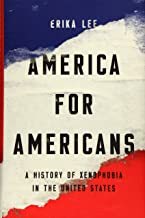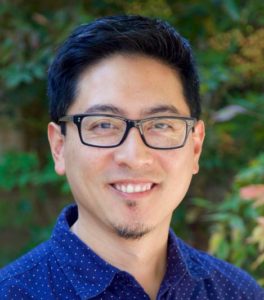America for Americans: A History of Xenophobia in the United States by Erika Lee. New York: Basic Books, 2019. vii + 416 pages, hardcover, ISBN: 978-1-54-167260-4. US$32.

According to United States census projections, more than half of all Americans are estimated to belong to a minority group by 2044.1 Combined with factors such as higher birthrates and a declining white population, the number of foreign born—anyone who is not a US citizen at birth—is expected to grow to 78 million by 2060 representing 18.8 percent of the total US population. While overall public opinion regards immigrants as having a positive contribution to American society,2 recent policies, such as the “Muslim Ban” (Executive Order 13769) and anti-Asian racism engendered by the COVID-19 pandemic, paint a contradictory picture of American acceptance of minorities and immigrants.
Authored by Erika Lee, chair of Immigration History and director of the Immigration History Research Center at the University of Minnesota, America for Americans: A History of Xenophobia in the United States, delves into the long and complicated record of hostility, racism, and violence toward immigrants in American history and attempts to offer an answer to this contradiction.
The title of the book comes from Theodore Roosevelt’s 1916 “America for Americans” speech in which he embraced the ideal of America as a nation of immigrants while exhorting them to cast off their hyphenated identities and fully assimilate to become indistinguishable members of an entirely new race, “a nationalized and unified America” (p. 6).
While Roosevelt’s speech sounds benign, groups such as the KKK later appropriated the phrase “America for Americans” to advance nativist and racist agendas. Exactly who is an American, who decides what “American” is, and who gets to become American? These questions are part of the larger issue of xenophobia which Lee sees animating the inherent contradiction between America as the “shining city upon a hill” and the enduring racism that haunts American society.
That the fear of foreigners has been a constant and defining feature of American life is an open secret already examined by numerous authors and scholars. America for Americans is one of the few books that links various anti-immigrant campaigns which have flared up throughout American history and understands them in relation to each other. There should be no surprise xenophobia is not only endemic but also innate to the American experience.
Taking a synchronic approach, Lee meticulously examines the ways xenophobia manifests itself and how it is directed at specific groups of immigrants throughout American history. Beginning with the pre-Revolutionary War period and ending with the Muslim Ban of 2017 enacted by the Trump administration, the book does well to point out that the fear of foreigners manifests contemporary social, political, and economic anxieties.
One of the most infamous episodes of American xenophobia, the restriction and exclusion of Chinese immigrants from settling in the US, lasted 61 years from 1882 until 1943. Known as the Chinese Exclusion Act of 1882, this was the first and only law enacted to prevent all members of a specific ethnic or national group from immigrating to the US.
The history of Chinese in North America began in the 1840s with the California Gold Rush and the building of the transcontinental railroad. An American demand for cheap labor combined with a declining socio-economic climate in China encouraged large numbers of Chinese to immigrate to the US. Chinese laborers made up ninety percent of the Central Pacific Railroad workforce and were hired to clear trees, blast through mountains, and lay tracks heading east from Sacramento.
By 1870, there were more than 63,000 Chinese in the US and three-quarters of them lived in California. Chinese workers became indispensable in mines, factories, farms, and vineyards of the American West. They faced much discrimination but worked in jobs that were thought to be too dirty, dangerous, or degrading to white men and were paid on a separate and lower wage scale from whites.
Lee notes because they were not white, Chinese Americans were treated more like African Americans and Native Americans as “race problems to be stringently controlled (as in Jim Crow segregation) or expelled and driven off (as in the ongoing war against Native Americans)” and were denied rights and freedoms, including the right to become a naturalized citizen (p. 81).
The movement behind anti-Chinese sentiments grew out of anti-Irish xenophobia of the 1850s. What made the Chinese Exclusion Act possible was an already existing and well-defined anti-immigrant political movement based on grassroots organizing, populism, and secrecy that coalesced in the Know Nothing Party.
By the 1850s, the Irish became the target of xenophobia due to their perceived fear that Catholic outsiders were intent on infiltrating the US. Irish immigrants were scapegoats for America’s social, political, and economic problems. Anti-Irish xenophobia was not only about religion, but also class, national origin, and race. Race became a category that scientists used to delineate people into groups by ascribing inherited and immutable characteristics to them. Irish immigrants were linked to Native Americans as a way to demonstrate Irish racial inferiority.
The Know Nothings capitalized on public discontent over political corruption and the government’s inability to regulate immigration to propel themselves into political offices. The Know Nothings also appropriated Native American symbols to claim native status and defined Anglo-Saxon Americans in opposition to foreigners. Though successful for only a short period, the politics of the Know Nothings set the stage for xenophobia directed toward the Chinese beginning in the 1850s.
While Chinese immigrants were integral to the construction of the American West, an economic crash in the 1870s fomented xenophobia toward the Chinese. Ironically, those advocating anti-Chinese actions were union organizers and Irish Americans who saw their work siphoned away by coolie labor.
Much like Native Americans, the Chinese experienced riots, violence, and forced removals. Through various political maneuverings on the regional and national level, anti-Chinese organizers were successful in passing the Chinese Exclusion Act (CEA) of 1882 which prohibited all members of a specific ethnic group from immigrating to the US. The CEA also marked the first time the term “illegal immigration” became part of American discourse where a specific ethnic group were put under surveillance.
The book also examines other episodes of xenophobia in American history—anti-German and anti-Native American sentiments in the pre-Revolutionary War period, the perceived “Catholic horde” inundating America from the shores of Europe, the mass deportations of Mexican Americans in the 1930s, and the internment of Japanese Americans during WWII.
In the last three chapters of the book, Lee examines the evolution of xenophobia in contemporary American society. The landmark Immigration Act of 1965 ended the national origins system and abolished the policy of admitting immigrants according to racist ideas of “inferior” and “superior” groups of people, and unequal quotas that reinforced that racism. While the new law did end the unfair quota system, it still masked the color-blind xenophobia prevalent in American society.
One key element of the Immigration Act of 1965 is the cap on immigration from the Western Hemisphere. While not explicitly stated, this provision is designed to curtail immigration from Latin American countries, especially Mexico. This ceiling would also set the stage for the massive influx of undocumented migrants due to political unrest and economic instability in Central America in the 1990s and 2000s.
Anti-immigration advocates such as Patrick Buchanan, who unsuccessfully ran on the “America First” platform for the Republican presidential nomination, capitalized on the perceived influx of undocumented migrants to further an “American-only” political agenda. This was realized in California’s Proposition 187, approved via voter referendum in 1994. The main goal of Proposition 187 was to deny health care and public education to undocumented immigrants.
The proposition relied on race-neutral language and fiscal conservatism while deploying the racially coded term of “illegal immigration” as an undeniably and exclusively Mexican problem. Lee points out this episode of xenophobia unified a variety of conservatives in the US whose impact can still be felt today in the Muslim Ban of 2017, anti-Chinese rhetoric, and the denial of international student visas which the current White House administration has attempted to pass via presidential executive orders.
One will indeed feel a heaviness of heart after reading this book given the long history of xenophobia and its current manifestations in American society. Xenophobia is as American as apple pie. Xenophobia has not gone away and has evolved to be more sophisticated in its discourse and tactics.
While America for Americans is a volume not in the purview of critical race theory, the book does make the question of race front and central. Although America for Americans does not prescribe solutions to racism and xenophobia, the book does well in meticulously excavating this troubling history for the reading public. The question that remains is: How now shall we live and be in the world in light of this history? This history is one all should understand, examine, and reflect upon, especially for those engaging in Christian ministry that seeks the reconciliation of all to Christ and all to all.
Endnotes
- Sandra Colby and Jennifer Ortman. 2015. “Projections of the Size and Composition of the U.S. Population: 2014 to 2060.” US Census Bureau.
- Abby Budiman. 2020. “Key findings about US immigrants.” https://www.pewresearch.org/fact-tank/2020/08/20/key-findings-about-u-s-immigrants/. Accessed September 15, 2020.

Steven Hu
Steven Hu is a Ph.D. candidate in the Department of Religious Studies at the University of California Santa Barbara. His research examines Christian urbanism, place-making, and the politics of affective spaces in contemporary China. View Full Bio